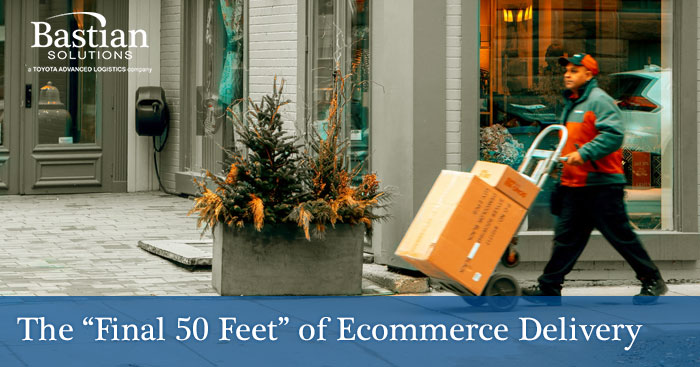
The "Final 50 Feet" of Ecommerce Delivery: Trends, Challenges, and Technology
Mike Senuta | 13 February 2020
Much of the focus among distribution center (DC) operators and material handling providers in handling the growth of ecommerce has been on DC networks and inside the four walls. Ecommerce order profiles and tight service levels continue to drive changes in DC design, processes, and technology. At the same time, parcel carriers and the U.S. Postal Service have been wrestling with the deluge of parcel deliveries and rapidly adapting operating models while dealing with increased costs. For example - UPS and FedEx incurred a combined $48.7 million in parking fines in New York City in 2018!
While the “last mile” has long been a focus for retailers and carriers, one particularly challenging element of the last mile getting increased attention is the “final 50 feet” of urban parcel delivery - generally defined as the activity from parking the vehicle to handing off the parcel(s).
The scale and complexity of the urban freight challenge is large and growing:
- Ecommerce growth – over 20 percent of retail sales volume is expected to be on-line by 2025, according to FTI’s 2019 U.S. Online Retail Forecast
- Urban population growth – the percentage of the world’s population living in urban areas will increase from 54 percent in 2018 to 68 percent by 2050, per a recent UN study.
- Service levels – customers are increasingly expecting same or next day delivery
Amazon and some major retailers have transitioned to metro ecommerce DCs, which are smaller than conventional regional DCs, and located on the fringes of metropolitan areas. These DCs serve to increase capacity and service levels - but do nothing to address the final 50 feet.
Final 50 feet obstacles are substantial:
- Cities are ill-equipped to handle current ecommerce delivery volume
- Traffic congestion and scarcity of parking
- Access to residential buildings for delivery
- Impact on sustainability and urban livability
- Carbon footprint of delivery truck activity
- Amount of packaging with more/smaller retail orders
- Congestion and its impact on mobility and livability
In addition, the emergence and growth of ridesharing and food delivery services compounds traffic and curbside parking challenges.
Bottom line – the last mile models that have served us well for decades will need to change dramatically to support 21st century needs in urban areas.
Fortunately, innovation is occurring to meet the challenge. New concepts and technologies are being piloted in Europe (and more recently) North America, and the issue is getting increased attention from retailers, carriers, government and academia. Solutions will require unprecedented private-public collaboration - one such example is the Urban Freight Lab at the University of Washington.
Two key metrics often cited in studies of urban package delivery are:
- Delivery vehicle dwell time - how long is the vehicle parked while making a delivery?
- First delivery attempt success rate
Significant improvement in these two metrics will require new operating models and technologies and will yield reduced congestion and delivery cost.
Some promising innovations involve consolidating and staging multiple package streams in a central point within a neighborhood for final delivery. Final delivery could be handled by a single carrier, on foot or with electric cargo bicycles, with autonomous delivery robots, or even by crowdsourcing apps. In addition, a major area of focus has been on increasing efficiency of the final handoff from carrier to recipient and allowing for unattended parcel drop-off and pick-up.
Here are few relevant concepts to be aware of:
- Micro-fulfillment centers (MFC) – small, localized fulfillment operations, often automated and located within existing brick-and-mortar retail space
- Urban consolidation centers (UCC) – consolidation points within or adjacent to urban areas to facilitate efficient last mile delivery. UCC’s have been piloted in several locations in Europe.
- Micro-hubs – small, portable consolidation/staging points within an urban neighborhood
- Secure package lockers – located in building lobbies or in public spaces such as near transit stops; carriers place package in individual locker, recipient is notified to pick up by text or e-mail.
- Package AS/RS systems – mini-AS/RS systems; similar to locker concept, except with greater parcel holding capacity, and load/pickup via self-service port.
- Drones and Autonomous Delivery Robots – development and pilot programs continue, may be a part of an overall urban solution
- “Curb Data” – shared data on parking spots, with real-time availability updates, for use by delivery and ride-share drivers.
Over the next ten years we can expect to see partnerships between retailers, carriers, government and academic institutions drive the piloting of concepts and technologies, ultimately leading to transformative changes in urban package delivery models.
The team at Bastian Solutions is committed to pioneering and implementing material handling solutions from end-to-end of the supply chain. Contact us if you'd like to learn more.
Mike Senuta is a Senior Consulting Engineer with Bastian Solutions, based in Indianapolis. In this role, he works with customers across North America to come up with innovative solutions to a broad range of distribution and material handling challenges. Mike has extensive experience in DC engineering and operations.
Comments
No comments have been posted to this Blog Post
Leave a Reply
Your email address will not be published.
Comment
Thank you for your comment.